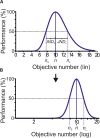Absolute Numerosity Discrimination as a Case Study in Comparative Vertebrate Intelligence
- PMID: 32849085
- PMCID: PMC7426444
- DOI: 10.3389/fpsyg.2020.01843
Absolute Numerosity Discrimination as a Case Study in Comparative Vertebrate Intelligence
Abstract
The question of whether some non-human animal species are more intelligent than others is a reoccurring theme in comparative psychology. To convincingly address this question, exact comparability of behavioral methodology and data across species is required. The current article explores one of the rare cases in which three vertebrate species (humans, macaques, and crows) experienced identical experimental conditions during the investigation of a core cognitive capability - the abstract categorization of absolute numerical quantity. We found that not every vertebrate species studied in numerical cognition were able to flexibly discriminate absolute numerosity, which suggests qualitative differences in numerical intelligence are present between vertebrates. Additionally, systematic differences in numerosity judgment accuracy exist among those species that could master abstract and flexible judgments of absolute numerosity, thus arguing for quantitative differences between vertebrates. These results demonstrate that Macphail's Null Hypotheses - which suggests that all non-human vertebrates are qualitatively and quantitatively of equal intelligence - is untenable.
Keywords: categorication; crow; intelligence; monkey (Macaca mulatta); number cognition.
Copyright © 2020 Nieder.
Figures




Similar articles
-
Evolution of cognitive and neural solutions enabling numerosity judgements: lessons from primates and corvids.Philos Trans R Soc Lond B Biol Sci. 2017 Feb 19;373(1740):20160514. doi: 10.1098/rstb.2016.0514. Philos Trans R Soc Lond B Biol Sci. 2017. PMID: 29292361 Free PMC article. Review.
-
Honeybees use absolute rather than relative numerosity in number discrimination.Biol Lett. 2019 Jun 28;15(6):20190138. doi: 10.1098/rsbl.2019.0138. Epub 2019 Jun 19. Biol Lett. 2019. PMID: 31213140 Free PMC article.
-
Macphail's Null Hypothesis of Vertebrate Intelligence: Insights From Avian Cognition.Front Psychol. 2020 Jul 8;11:1692. doi: 10.3389/fpsyg.2020.01692. eCollection 2020. Front Psychol. 2020. PMID: 32733351 Free PMC article. Review.
-
Behavioral and Neuronal Representation of Numerosity Zero in the Crow.J Neurosci. 2021 Jun 2;41(22):4889-4896. doi: 10.1523/JNEUROSCI.0090-21.2021. Epub 2021 Apr 19. J Neurosci. 2021. PMID: 33875573 Free PMC article.
-
Searching for the Critical p of Macphail's Null Hypothesis: The Contribution of Numerical Abilities of Fish.Front Psychol. 2020 Jan 31;11:55. doi: 10.3389/fpsyg.2020.00055. eCollection 2020. Front Psychol. 2020. PMID: 32116895 Free PMC article. Review.
Cited by
-
Quantitative abilities of invertebrates: a methodological review.Anim Cogn. 2022 Feb;25(1):5-19. doi: 10.1007/s10071-021-01529-w. Epub 2021 Jul 19. Anim Cogn. 2022. PMID: 34282520 Free PMC article. Review.
-
Information Theory Opens New Dimensions in Experimental Studies of Animal Behaviour and Communication.Animals (Basel). 2023 Mar 26;13(7):1174. doi: 10.3390/ani13071174. Animals (Basel). 2023. PMID: 37048430 Free PMC article. Review.
-
Towards a standardization of non-symbolic numerical experiments: GeNEsIS, a flexible and user-friendly tool to generate controlled stimuli.Behav Res Methods. 2022 Feb;54(1):146-157. doi: 10.3758/s13428-021-01580-y. Epub 2021 Jun 11. Behav Res Methods. 2022. PMID: 34117632 Free PMC article.
-
The role of motor effort on the sensorimotor number system.Psychol Res. 2024 Nov;88(8):2432-2443. doi: 10.1007/s00426-024-02002-2. Epub 2024 Jul 9. Psychol Res. 2024. PMID: 38980356 Free PMC article.
-
Zebrafish excel in number discrimination under an operant conditioning paradigm.Anim Cogn. 2022 Aug;25(4):917-933. doi: 10.1007/s10071-022-01602-y. Epub 2022 Feb 18. Anim Cogn. 2022. PMID: 35179665 Free PMC article.
References
Publication types
LinkOut - more resources
Full Text Sources

